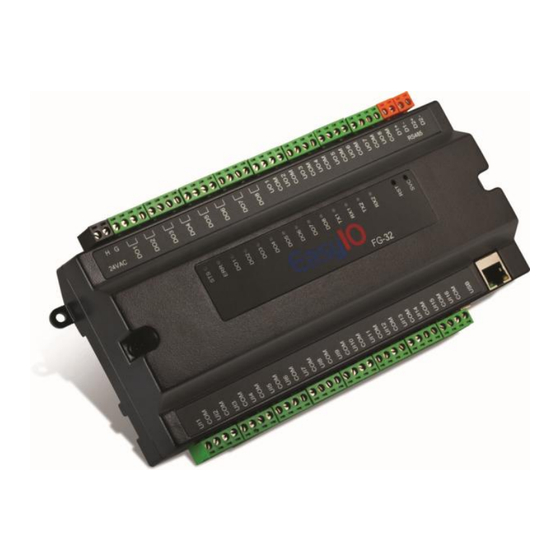
Summary of Contents for EasyIO Sedona
- Page 1 EasyIO Quick Start 02 – Sedona Workbench EasyIO Quick Start 02– Sedona Workbench Nov 2013...
- Page 2 EasyIO Quick Start 02 – Sedona Workbench Document Change Log Nov 2013 Document created. Nov 2013 Grammar Checked.
- Page 3 EasyIO Quick Start 02 – Sedona Workbench Disclaimer EasyIO 30P is a product by EasyIO Holdings Pte Ltd ® The EasyIO 30P was built on the Sedona Framework EasyIO FG-32 is a product by EasyIO Holdings Pte Ltd ® The EasyIO FG-32 was built on the Sedona Framework...
-
Page 4: Table Of Contents
EasyIO Quick Start 02 – Sedona Workbench Table of Contents Introduction ..............................5 Sedona Workbench Overview ........................6 Sedona Tools ..............................8 Kits Manager ............................... 8 Application Manager ..........................11 Backup/Restore Tool ..........................12 Sedona Apps ..............................15 Technical Support ............................19... -
Page 5: Introduction
Introduction Thank you for purchasing EasyIO products. This user guide will help in getting you programming an EasyIO Sedona controller in no time. This User Guide is compatible with both the EasyIO 30P and the EasyIO FG Series controllers. In this user guide Tridium Niagara Workbench 3.7.106 and Sedona Workbench version is 1.2.28.4 used. -
Page 6: Sedona Workbench Overview
Sedona Workbench Overview A Sedona Controller consists of two parts. See image below. If you are not able to see this view, please refer to EasyIO Quick Start 01 to connect to the Sedona Controller. Sedona Tools is where you manage Sedona kits in a controller, getting backup and doing apps restore. - Page 7 EasyIO Quick Start 02 – Sedona Workbench All other control logic should be dropped in the “EasyIO” folder or any other newly created folder(s) that identify the application or process involved. An example below shows multiple folders in the App folder.
-
Page 8: Sedona Tools
Kit manager in Sedona workbench is used to Sedona manage kits in a Sedona Controller. Kits that are installed in to a Sedona controller can be view in the Sedona Palette. Only objects from the kits that are installed is useable. - Page 9 To uninstall a kit, uncheck the selection box beside the kit name. **Note ** DO NOT attempt to install non EasyIO kits that are not Sedona Framework version 1.0.45. Only Non Easy IO kits that are Sedona Framework 1.0.45 should be installed. Non EasyIO kits do not use the word “easyio”...
- Page 10 If you are satisfied with the kits selected for installation, click Next and Finish at the bottom of the window. The Sedona workbench will begin to install the selected kits into the controller. The Sedona Workbench prompt for a Sedona VM for a restart. Hit restart restart the Sedona VM.
-
Page 11: Application Manager
You can replace this with a name of your choice as the filename. The “.sab” extension must remain. The Sedona app file will be saved in the file path/directory shown below. The path/directory is in the niagara workbench Sedona folder. -
Page 12: Backup/Restore Tool
Sedona VM (Virtual Machine), a manual reconnection is required. Backup/Restore Tool Unlike the “Get” and “Put” functions the “Backup” and “Restore” functions provide for storage and restoration of both the app.sab and the kit.scode files to/from a Sedona Controller. This provides a full controller back up. - Page 13 Choose the backup option and give the backup a name for the backup. Remember the extension has to be .zip. By default the Sedona app file will be saved in the file path/directory shown below. The default backup directory Is not changeable.
- Page 14 EasyIO Quick Start 02 – Sedona Workbench The Sedona Workbench will begin the upload process and on completion will prompt to restart the controllers’ Sedona VM (Virtual Machine). You will need to manually reconnect to the controller again.
-
Page 15: Sedona Apps
Assuming you understand all the Sedona Tools options functions and usage, the next guide will be a basic simple guide to construct/program a Sedona controller. Refer below for further steps. In this section of the user guide an EasyIO FG series controller is used in all the examples. - Page 16 EasyIO Quick Start 02 – Sedona Workbench Locate the Ramp object select it with a single click and holding down the mouse button, ‘Drag’ the Ramp object into the workspace. When it is placed in the desired location release the mouse button and ‘Drop’...
- Page 17 Connect the WriteFl object to the CMPR ‘y’ input in the same manner. Step 7 Next, locate and expand the easyioFG in the Sedona Palette sidebar. Locate, Drag and Drop a DO object from the easyioFG Library into the Workspace.
- Page 18 (x is greater than zero). Step 11 At this point in the programming process, your Sedona app programmed in the controller is not saved to the flash memory. It is resident in the controller and running in the controller RAM.
-
Page 19: Technical Support
EasyIO Quick Start 02 – Sedona Workbench Technical Support For technical issue, please contact Email:support@easyio.com...


Need help?
Do you have a question about the Sedona and is the answer not in the manual?
Questions and answers